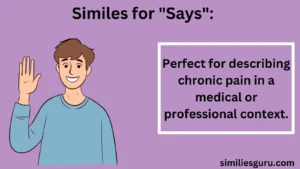What Is a Simile?
A simile is a figure of speech that compares two different things using the words “like” or “as.” It helps make language more vivid and easier to understand—especially for young learners. For example, “as busy as a bee” compares someone working hard to a bee, which is known for always buzzing around and staying busy.
Similes are especially powerful for second graders because they:
- Spark imagination.
- Make learning language fun.
- Help students express ideas clearly.
- Improve reading and writing comprehension.
Why Similes Are Important for Second Graders
Second grade is a critical time for language development. Students begin transitioning from basic sentences to more descriptive and expressive writing. Similes play a key role in:
- Enhancing creativity.
- Encouraging storytelling.
- Developing emotional expression.
- Making conversations more colorful.
By learning and using similes, children gain a stronger grasp of descriptive language, which supports their reading, writing, and verbal skills.
10+ Similes Perfect for Second Graders
Below are more than ten similes that are not only age-appropriate but also easy to understand and apply. Each simile includes:
- Definition
- Example
- Tone variation (formal, casual, playful)
- When to use it
1. As Quiet as a Mouse
- Meaning: Very quiet
- Example: “She tiptoed into the room as quiet as a mouse.”
- Tone:
- Formal: “He entered with the subtle grace of a whisper.”
- Casual: “He was super quiet, like a little mouse!”
- Playful: “She snuck in like a ninja-mouse.”
- Formal: “He entered with the subtle grace of a whisper.”
- Best for: Classroom settings, bedtime stories, or anytime you want to describe someone being very quiet.
2. As Busy as a Bee
- Meaning: Extremely busy or hardworking
- Example: “He’s been as busy as a bee with his school project.”
- Tone:
- Formal: “She has been highly productive today.”
- Casual: “He’s buzzing around getting things done!”
- Playful: “She’s been zipping around like a bee in a flower shop!”
- Formal: “She has been highly productive today.”
- Best for: Describing students, teachers, or even parents who are multitasking or working hard.
3. As Happy as a Clam
- Meaning: Very happy or content
- Example: “She was as happy as a clam on her birthday.”
- Tone:
- Formal: “She appeared to be in a state of genuine delight.”
- Casual: “He looked super happy!”
- Playful: “She smiled so big, like a clam with a secret!”
- Formal: “She appeared to be in a state of genuine delight.”
- Best for: Celebration moments or times of joy in a child’s life.
4. As Light as a Feather
- Meaning: Very light in weight
- Example: “The kitten was as light as a feather in my arms.”
- Tone:
- Formal: “It was exceptionally lightweight.”
- Casual: “It felt like nothing!”
- Playful: “So light, like it could fly away with a sneeze!”
- Formal: “It was exceptionally lightweight.”
- Best for: Describing objects, pets, or even feelings like being carefree.
5. As Brave as a Lion
- Meaning: Very brave or courageous
- Example: “He was as brave as a lion during the school play.”
- Tone:
- Formal: “He displayed admirable courage.”
- Casual: “He was super brave!”
- Playful: “He roared through his fears like a lion king!”
- Formal: “He displayed admirable courage.”
- Best for: Encouraging self-confidence and celebrating bravery in kids.
6. As Fast as a Cheetah
- Meaning: Extremely fast
- Example: “She ran across the playground as fast as a cheetah.”
- Tone:
- Formal: “Her speed was impressive and swift.”
- Casual: “She zoomed!”
- Playful: “She dashed like a cheetah on roller skates!”
- Formal: “Her speed was impressive and swift.”
- Best for: Sports, races, and any high-energy activity descriptions.
7. As Cold as Ice
- Meaning: Very cold
- Example: “The water was as cold as ice!”
- Tone:
- Formal: “It was freezing to the touch.”
- Casual: “That was icy cold!”
- Playful: “Brrr! Colder than a snowman’s toes!”
- Formal: “It was freezing to the touch.”
- Best for: Weather talk, drinks, or sensory experiences.
8. As Sweet as Candy
- Meaning: Very sweet (personality or flavor)
- Example: “Her smile was as sweet as candy.”
- Tone:
- Formal: “She had a very kind demeanor.”
- Casual: “She’s super sweet.”
- Playful: “She’s like walking sugar!”
- Formal: “She had a very kind demeanor.”
- Best for: Compliments or talking about kindness.
9. As Slow as a Snail
- Meaning: Very slow
- Example: “He walked as slow as a snail to school.”
- Tone:
- Formal: “He was significantly delayed.”
- Casual: “He took forever!”
- Playful: “He moved like a sleepy snail on vacation.”
- Formal: “He was significantly delayed.”
- Best for: Fun complaints or humor in describing slow movement.
10. As Bright as the Sun
- Meaning: Very bright
- Example: “Her dress was as bright as the sun.”
- Tone:
- Formal: “It radiated vivid brilliance.”
- Casual: “So bright and sunny!”
- Playful: “She glowed like a mini-sun with sparkles!”
- Formal: “It radiated vivid brilliance.”
- Best for: Compliments, artistic expression, or descriptions of light.
11. As Hungry as a Bear
- Meaning: Very hungry
- Example: “He was as hungry as a bear after gym class.”
- Tone:
- Formal: “He had a large appetite.”
- Casual: “He was starving!”
- Playful: “He could eat a picnic, just like a bear!”
- Formal: “He had a large appetite.”
- Best for: Meal times or describing appetite with fun imagery.
Texting Examples (Google-Optimized & Friendly for Parents and Teachers)
Here are six kid-friendly, Google-friendly texting examples using similes from above:
- 🐝 “Just finished cleaning the classroom—felt as busy as a bee today!”
- 🦁 “Maya was as brave as a lion at the dentist! So proud.”
- 🐌 “Leo walked to the car as slow as a snail 😂”
- 🧊 “That drink was as cold as ice! 🥶”
- 🌞 “Her art was as bright as the sun—such talent!”
- 🐻 “Coming home from school as hungry as a bear! 🍽️”
These are perfect for classroom updates, parenting chats, or friendly conversations that need a dash of descriptive language.
How to Choose the Best Simile: Tone & Context Tips
When helping children understand or use similes, context and tone matter. Here’s how to choose the right one:
1. Know Your Audience
- Formal settings: Use more polished similes or explain their meanings.
- Casual moments: Let the creativity shine with playful or silly similes.
2. Match the Emotion
- Want to express joy? Use similes like happy as a clam or bright as the sun.
- Describing effort? Try busy as a bee or brave as a lion.
3. Encourage Creativity
- Let kids come up with their own similes, like:
- “As bouncy as a ball of jelly.”
- “As sleepy as a kitten in a basket.”
- “As bouncy as a ball of jelly.”
Conclusion
Similes are powerful tools that unlock the creative potential of second graders. By using age-appropriate comparisons, students not only build language skills but also learn to see the world in imaginative ways. Whether you’re a teacher, parent, or language lover, these similes offer a vibrant pathway into storytelling, learning, and fun.
Use this list as a starting point, but don’t stop here—encourage your second grader to make their own similes and share them in daily conversations, writing assignments, or just for fun!



